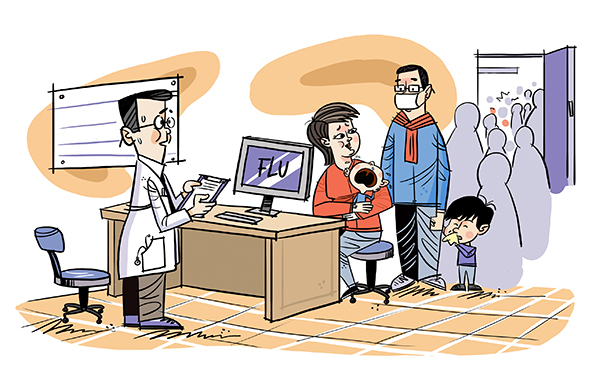Primary care system failure adds to flu chaos


The flu outbreak this winter has been severer with more cases being reported than previous years, sparking a public outcry over the weak primary care system in the country. Large hospitals in most Chinese cities, especially in North China, were overflowing with patients showing flu-like symptoms-and that many of them were later diagnosed to be suffering from just common cold showed they could have been treated by primary care facilities instead of visiting large hospitals.
The situation is worse in pediatric departments of hospitals, which in general are short-staffed. Last week, a large Tianjin hospital temporarily shut down its pediatric department because the pediatricians were either too exhausted to work after handling an overwhelmingly high number of patients or had fallen ill themselves.
In China, people prefer visiting large hospitals for treatment without referral from primary care facilities. This somewhat neutralizes the effectiveness of primary care centers, which are supposed to play the role of "gatekeepers". In a large developing country providing universal healthcare, it also inflates the insurance cost.
By the end of 2016, China had more than 920,000 primary care facilities at the grassroots level. Many more such facilities will be set up so that they can handle almost all the patients needing basic medical treatment. On the other hand, large hospitals will be downsized and only receive serious and complicated cases in the future.
Moreover, to improve the primary care system, the government has been taking measures to establish a comprehensive family doctor system-it already covers about 500 million Chinese people, or about 35 percent of the total population.
According to the plan, the doctors will work in public community clinics, acting as the "primary gatekeepers" of the healthcare system to optimize the medical resources through referrals. But the plan remains on paper, as even people suffering from common cold flock to large hospitals, leading to a waste of medical resources and specialists' medical knowledge and skills.
Besides, the performance of community clinics or primary care facilities is still poor nationwide-even in Beijing many patients running a temperature were refused treatment at community clinics with doctors saying the cause of the fever could be a major disease such as leukemia or complications from a stroke. But given the low, fixed paycheck, community doctors cannot be expected to handle patients with greater enthusiasm.
In China, on average less than 2 percent of the people get flu vaccines each year, and mainly low awareness is to be blamed for that. The community-level healthcare facilities are responsible for providing medical services for the people, and the doctors and nurses there are also supposed to act as health educators, teaching the people about the importance of flu vaccination and rational use of medicines.
Flu is difficult to prevent because the viruses are transmitted via the air and physical contact. And vaccination remains the best preventive measure against it. This flu season, however, has fully exposed the problems such as overcrowded large hospitals, exceptionally low vaccination coverage, and improper self-treatment with antiviral medication such as Tamiflu.
Had an efficient primary care system been in place, the people and the healthcare system could have handled the flu season with greater ease.
The author is a senior writer with China Daily. shanjuan@chinadaily.com.cn









































